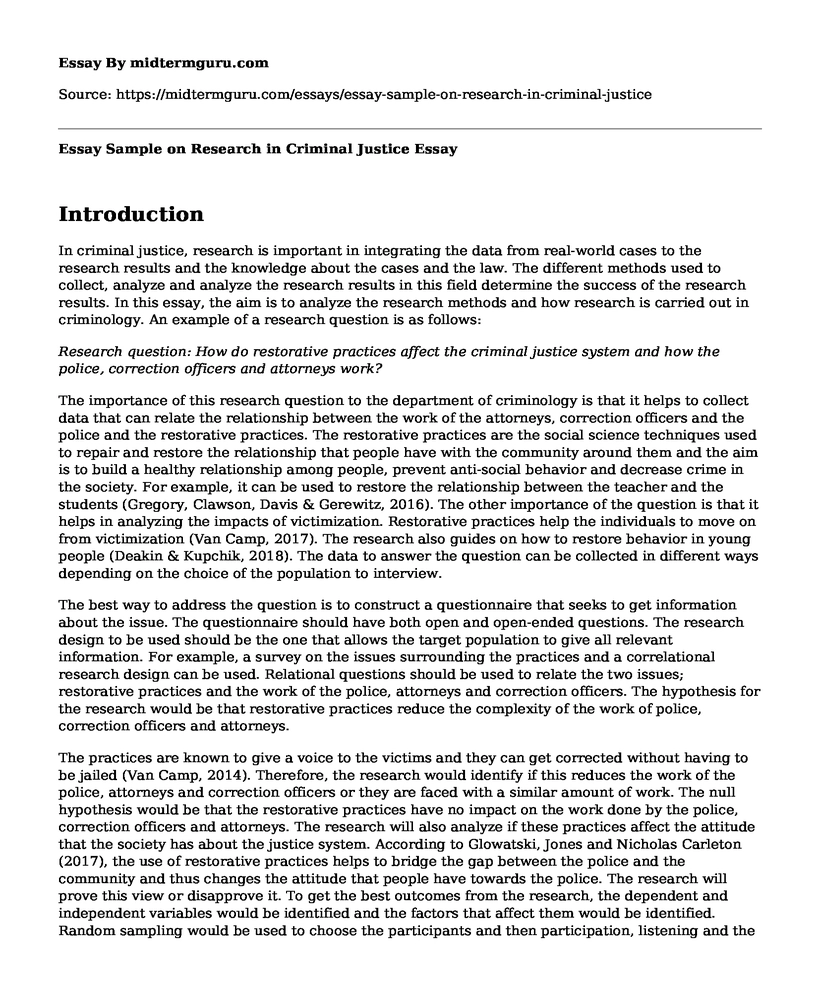Introduction
In criminal justice, research is important in integrating the data from real-world cases to the research results and the knowledge about the cases and the law. The different methods used to collect, analyze and analyze the research results in this field determine the success of the research results. In this essay, the aim is to analyze the research methods and how research is carried out in criminology. An example of a research question is as follows:
Research question: How do restorative practices affect the criminal justice system and how the police, correction officers and attorneys work?
The importance of this research question to the department of criminology is that it helps to collect data that can relate the relationship between the work of the attorneys, correction officers and the police and the restorative practices. The restorative practices are the social science techniques used to repair and restore the relationship that people have with the community around them and the aim is to build a healthy relationship among people, prevent anti-social behavior and decrease crime in the society. For example, it can be used to restore the relationship between the teacher and the students (Gregory, Clawson, Davis & Gerewitz, 2016). The other importance of the question is that it helps in analyzing the impacts of victimization. Restorative practices help the individuals to move on from victimization (Van Camp, 2017). The research also guides on how to restore behavior in young people (Deakin & Kupchik, 2018). The data to answer the question can be collected in different ways depending on the choice of the population to interview.
The best way to address the question is to construct a questionnaire that seeks to get information about the issue. The questionnaire should have both open and open-ended questions. The research design to be used should be the one that allows the target population to give all relevant information. For example, a survey on the issues surrounding the practices and a correlational research design can be used. Relational questions should be used to relate the two issues; restorative practices and the work of the police, attorneys and correction officers. The hypothesis for the research would be that restorative practices reduce the complexity of the work of police, correction officers and attorneys.
The practices are known to give a voice to the victims and they can get corrected without having to be jailed (Van Camp, 2014). Therefore, the research would identify if this reduces the work of the police, attorneys and correction officers or they are faced with a similar amount of work. The null hypothesis would be that the restorative practices have no impact on the work done by the police, correction officers and attorneys. The research will also analyze if these practices affect the attitude that the society has about the justice system. According to Glowatski, Jones and Nicholas Carleton (2017), the use of restorative practices helps to bridge the gap between the police and the community and thus changes the attitude that people have towards the police. The research will prove this view or disapprove it. To get the best outcomes from the research, the dependent and independent variables would be identified and the factors that affect them would be identified. Random sampling would be used to choose the participants and then participation, listening and the survey would be used to collect the desired data.
References
Deakin, J., & Kupchik, A. (2018). Managing Behaviour: From Exclusion to Restorative Practices. In The Palgrave International Handbook of School Discipline, Surveillance, and Social Control (pp. 511-527). Palgrave Macmillan, Cham.
Glowatski, K., Jones, N. A., & Nicholas Carleton, R. (2017). Bridging police and communities through the relationship: the importance of a theoretical foundation for restorative policing. Restorative Justice, 5(2), 267-292.
Gregory, A., Clawson, K., Davis, A., & Gerewitz, J. (2016). The promise of restorative practices to transform teacher-student relationships and achieve equity in school discipline. Journal of Educational and Psychological Consultation, 26(4), 325-353.
Van Camp, T. (2014). Victims of violence and restorative practices: finding a voice. Routledge.
Van Camp, T. (2017). Understanding victim participation in restorative practices: Looking for justice for oneself as well as for others. European Journal of Criminology, 14(6), 679-696.
Cite this page
Essay Sample on Research in Criminal Justice. (2022, Oct 24). Retrieved from https://midtermguru.com/essays/essay-sample-on-research-in-criminal-justice
If you are the original author of this essay and no longer wish to have it published on the midtermguru.com website, please click below to request its removal:
- Essay Sample: Should US Prisoners Be Given Minimal or Extended Medical Care?
- Essay Sample on Advantages of Keeping Offenders in Prison Environment
- Essay Sample on Equity, Justice and Human Dignity
- Research Paper on Crime Scene Profiling
- Article Analysis Essay on Government Surveillance of Citizens Raises Civil Liberty Concerns
- The Cognitive Dissonance Theory and the Stanford Prison Experiment - Research Paper
- Juvenile vs Adult Courts: Comparing a Case Study - Essay Sample







